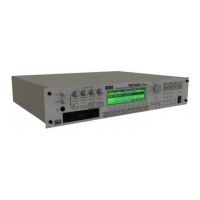SMPL
1.1
2.13.14.15.15.27.2
97
Before executing Time Slice on a long sample, you
should first divide the sample into measures. In some
cases, it may not be possible to assign the sample to the
note number or create pattern data.
Time Slices requires vacant samples, multisamples, and
relative parameters in order to execute. Be sure that
there is sufficient free area before you execute. If there is
insufficient free area, an error will occur.
If you open the Time Slice dialog box on the same sam-
ple, it will be sliced in the same way as previously.
These slice locations will also be used if you execute
Slice in “Time Stretch” (
☞3.1–2e), so that you can exe-
cute Time Stretch without having to make the settings
again.
If you wish to detect the attacks again or to re-do the
operation, change the “Sensitivity” after you open the
dialog box.
Time Stretch
Time Stretch is a function that modifies the tempo by length-
ening or shortening a sample without changing its pitch.
This is a convenient way to modify the tempo of a drum
rhythm loop or a melodic sample such as voice/string/
wind so that it matches the tempo of another sample or pat-
tern, or the tempo of an external MIDI sequencer. The TRI-
TON-Rack provides two ways in which Time Stretch can be
executed. This command also supports stereo samples.
Sustaining
This type is suitable for sustained sounds such as vocal or
instruments. Using it to change the tempo of phrases such as
guitar or piano will also produce good results.
Slice
This type is suitable for decay-type instruments such as
drums. Using it to change the tempo of drum or percussion
loops will produce good results with minimal effect on the
attack.
There is a way to change the pitch as well when chang-
ing the tempo of a rhythm loop sample (“Pitch BPM
Adj.” SMPL 4.1–3b, “Detune BPM Adj.” COMBI 3.1–3b,
MULTI 3.1–5b, –6b). You can create unique effects by
raising or lowering the pitch of drums etc.
To use Time Stretch (Sustaining)
1 Use “SMPL” (3.1–1b) to select the sample that you wish
to time stretch as Sustaining.
2 From the Edit2 page “UTILITY,” choose “Time Stretch”
to open the following dialog box.
3 Select “Sustaining” as the time stretch method.
Press the [F8] (“OK”) key to execute Time Stretch, or
press the [F7] (“Cancel”) key to cancel without executing.
If the L and R of a stereo sample are different in
length, blank data will automatically be added to the end
of the shorter sample so that it matches the longer side.
4 A dialog box for executing Time Stretch will appear.
5 Set “Quality” to specify the desired audio quality of the
sample produce by Time Stretch. The range is 0–7.
Although it will depend on the sample, higher settings
will produce better results. However, be aware that
higher settings will also require a longer time to execute.
Since you can try this as many times as you like, you
should normally start with about 4, and raise or lower
the setting gradually.
6 Set the proportional length of the sample that will be cre-
ated by Time Stretch.
• To specify the length as a ratio
Set “Ratio.” The available range is 50.00%–200.00%. If
you specify 50.00%, the sample length will be halved.
(The tempo will double.) If you specify 200.00%, the sam-
ple length will double. (The tempo will be halved.)
• To match an existing BPM tempo value
Set “Beat” as the number of quarter-note beats. When
you change “Beat,” the “Source BPM” value will be
changed automatically.
“Source BPM” will indicate the playback BPM value at
the original key. This BPM value is automatically calcu-
lated according to the length from the start address to the
end address (if loop is off) or from the loop start address
to the end address (if loop is on). If you already know the
BPM value and the calculated value is incorrect, change
it to the correct value.
Use “New BPM” to specify the BPM value of the sample
you wish to create. “Ratio” will automatically be calcu-
lated from the “Source BPM” and “New BPM” values.
For example if you have a one-measure 120 BPM sample
in 4/4 time, and would like to change it to 150 BPM, you
would set “Beat” to 4. The “Source BPM” will be calcu-
lated automatically. If the “Source BPM” is not calculated
as 120 due to inaccuracies in the start address (or loop
start address) or end address, adjust “Source BPM” to the
correct value of 120.
Next, set “New BPM” to 150. The “Ratio” will be calcu-
lated automatically.
It is not possible to make settings that would cause
“Source BPM” or “New BPM” to exceed the range of
40–480.
It is not possible to make settings that would cause
“Ratio” to exceed the range of 50.00–200.00.
Depending on the sample, the length may not be
exactly as you specify, due to limitations in processing
accuracy.
7 To execute the Time Stretch operation, press the [F8]
(“OK”) key. To cancel without executing, press the [F7]
(“Cancel”) key.
When you press the [F8] (“OK”) key, the Time Stretch
dialog box will appear.
8 Audition the sample that was created by Time Stretch.
The sample before being time-stretched is assigned to the
note number C2 of the keyboard, and the sample that
was time-stretched is assigned to note number C#2. You
can change the “Index” to check the waveform.
Index [Source(C2), Result(C#2)]:
Select the index for the sample whose waveform you
wish to display.
If you select Source, the original waveform before time-
stretching will be selected.

